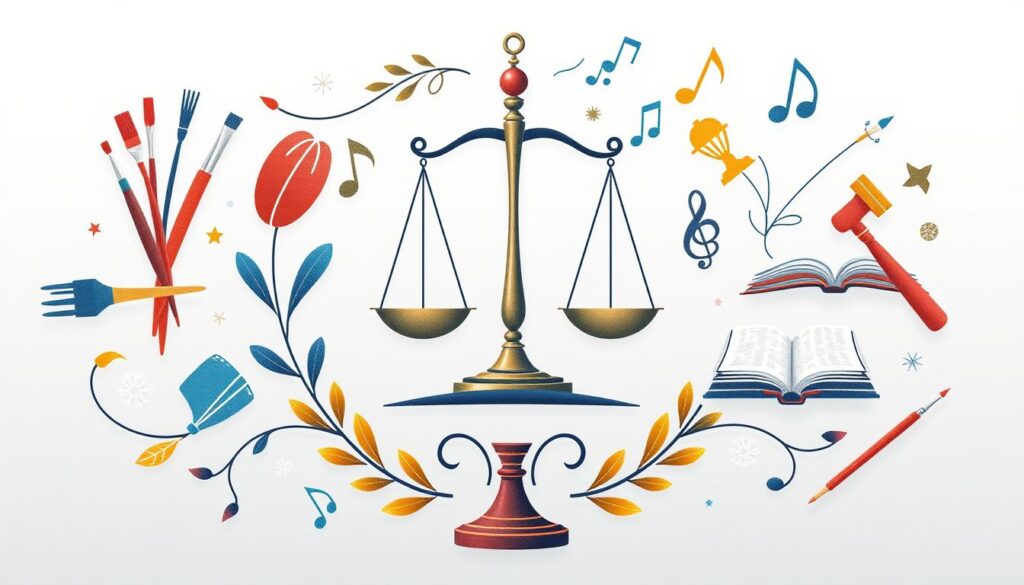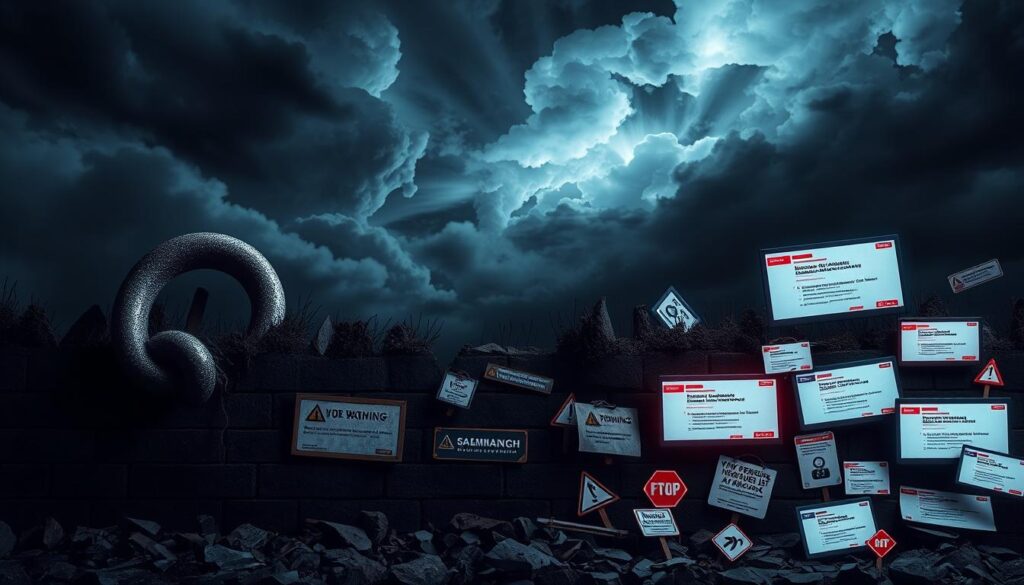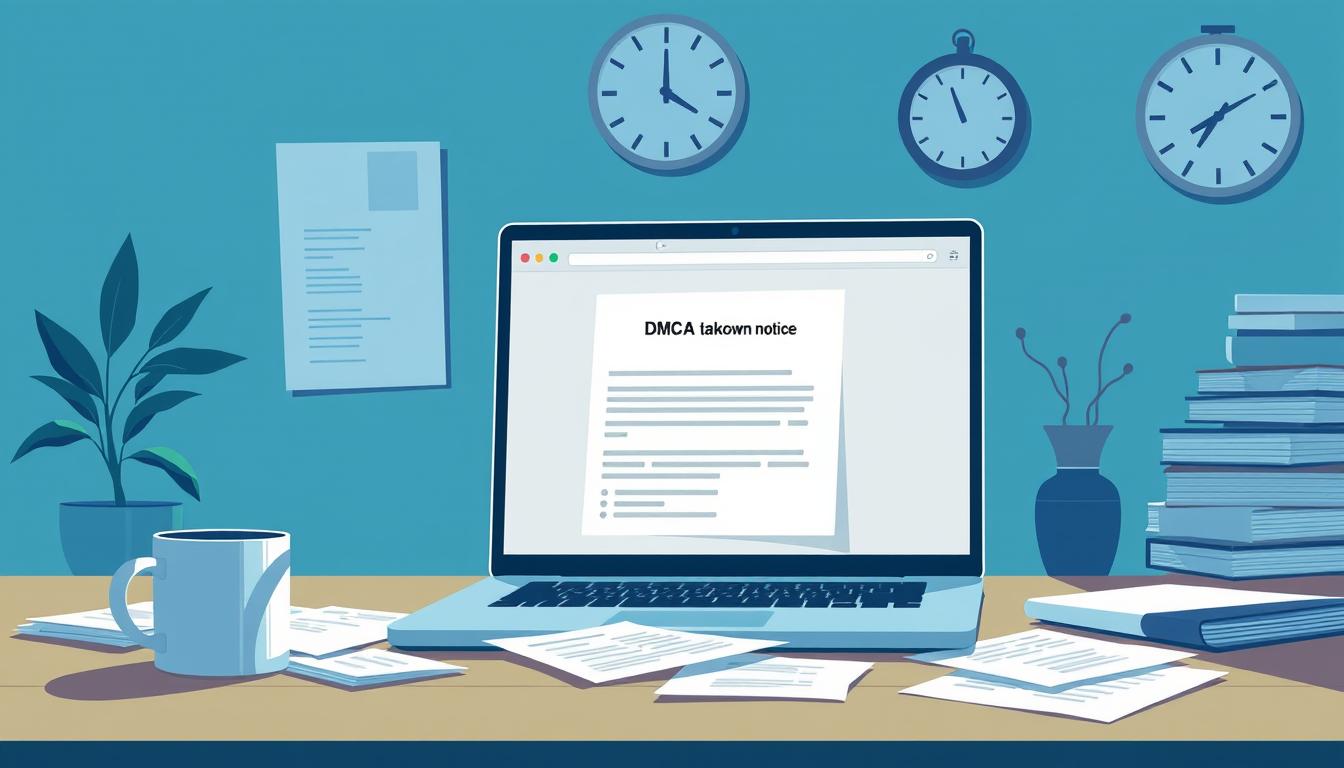How to Respond to a DMCA Takedown Notice: A Guide for Website Owners
Did you know that over 70% of DMCA takedown notices are sent in error? This alarming statistic underscores the significant impact of copyright infringement claims on website owners. Navigating the complexities of DMCA compliance is crucial for anyone managing online content. When you receive a DMCA takedown notice, it can feel overwhelming, but understanding your rights and the processes involved can empower you to respond effectively.
The Digital Millennium Copyright Act (DMCA) was signed into law in 1998 to protect intellectual property rights while balancing the interests of content creators and online platforms. Website owners must quickly grasp the implications of these notices, as they can lead to content removal and potential legal issues. This guide will equip you with the essential knowledge to respond appropriately and protect your rights if you face such a situation.
Key Takeaways
- Understanding DMCA Takedown Notices is essential for effective response.
- Timely actions can prevent content removal and legal repercussions.
- Identifying infringement correctly is crucial for DMCA compliance.
- Fair use evaluations can help defend against wrongful claims.
- Preparing a counter-notice requires detailed information and accuracy.
Understanding DMCA Takedown Notices
A DMCA takedown notice serves as a formal request initiated by copyright holders to eliminate infringing content from various online platforms. This process allows content owners to protect their intellectual property effectively. The DMCA, enacted in 1998, modernizes copyright law to address the unique challenges posed by the digital landscape.
Online service providers, including internet service providers and website operators, often receive DMCA takedown notices. The significance of these notices lies in their potential to shield providers from secondary liability. When a valid notice is issued, it must include specific elements, such as a clear indication of the infringing material and detailed information about the original copyrighted work. Failure to include these elements may lead to the refusal of the service provider to act on the notice.
The DMCA provides a streamlined process for content owners to assert their rights. It’s noteworthy that copyright owners do not have to register their works with the U.S. Copyright Office to initiate a takedown request. Many service providers even offer online tools for submitting these claims, facilitating the process for users.
Upon receiving a takedown notice, the service provider is required to alert the alleged infringer, who may subsequently issue a counter notice. This counter notice must adhere to the conditions set forth by the DMCA to ensure validity. Importantly, should no legal action be initiated by the copyright owner, service providers typically wait 10 to 14 days before reinstating the contested content.
| Aspect | Details |
|---|---|
| Purpose | To request removal of unauthorized content |
| Applicable Parties | Content owners, online service providers, ISPs |
| Key Requirements | Clear identification of infringing material, description of original work |
| Process Initiators | Any copyright holder, regardless of registration status |
| Response Time Frame | 10-14 days after valid counter notice is received |
| Global Acceptance | Standard practices widely recognized, not limited to the U.S. |
Understanding the mechanics of DMCA takedown notices is essential for content owners aiming to safeguard their rights in the digital sphere while enabling online service providers to comply with copyright regulations appropriately.
What is Copyright Infringement?
Copyright infringement occurs when someone uses copyrighted material without authorization or lawful exception. This includes activities like reproducing, distributing, displaying, or performing copyrighted works without permission from the rightful owner. Understanding the nuances of copyright infringement is essential for anyone engaged in content creation or distribution.
Intellectual property rights play a critical role in protecting the interests of creators by providing them with exclusive rights to their works. These rights are designed to prevent unauthorized use of their intellectual property, allowing them to control how their creations are shared and utilized. With the rapid increase in digital content sharing, the need for strong protections against copyright infringement has become even more evident.
Statistics reveal that around 77% of copyright infringement cases arise from unintentional violations, such as sharing images on social media. Approximately 23% of cases involve intentional infringements, highlighting varying degrees of awareness regarding copyright laws. The high volume of DMCA takedown notices received by Internet Service Providers demonstrates the ongoing issue of unauthorized use.
The Digital Millennium Copyright Act (DMCA) serves as a framework for addressing copyright infringement online. Since its enactment in 1998, the DMCA has significantly contributed to reducing instances of unauthorized use of copyrighted content on the internet. Although only about 5% of copyright infringement cases escalate to legal action, the implications of unaddressed infringement can be severe, ranging from statutory damages of $750 to $30,000 per work for willful infringement.
How to Respond to a DMCA Takedown Notice
Receiving a DMCA takedown notice can be a daunting experience for website owners. Understanding how to navigate this situation is crucial for effective copyright protection. The first action involves assessing the validity of the claim against your content. Check whether your content legitimately infringes upon copyright. If you believe the notice is unfounded, preparing a DMCA Takedown Notice response becomes necessary.
Immediate Steps to Take When You Receive a Notice
Upon receiving a DMCA takedown notice, follow these initial steps:
- Review the notice thoroughly to understand the specific claims against your content.
- Identify the copyrighted work mentioned in the notice to assess its legitimacy.
- Gather evidence showing your rightful use of the content, if applicable.
- If the notice appears unjust, formulate a counter-notice to challenge it.
Importance of Timely Response
Responding promptly to a DMCA notice is critical in ensuring copyright protection of your work. Typically, you have 14 days to respond before your content is permanently removed. Delaying your response can jeopardize your chance of restoring your content, exposing you to potential copyright infringement lawsuits. While there is no specific time frame for counter-notices, acting quickly is always in your best interest. A failure to respond can lead to serious repercussions, including legal claims based on Section 512(f) of the DMCA.
| Action | Details |
|---|---|
| Evaluate Notice | Determine if the claim is valid or makes erroneous copyright assumptions. |
| Gather Evidence | Collect documentation supporting your case if you plan to file a counter-notice. |
| Response Timeframe | Typically 14 days to respond to avoid removing infringing content. |
| Filing a Counter-Notice | Helpful if you believe the takedown notice lacks merit; act promptly. |
The Process of DMCA Compliance
Understanding the process of DMCA compliance is essential for both content owners and internet service providers. When a service provider receives a DMCA takedown notice, they must act swiftly to ensure compliance with the law. This process typically involves several steps aimed at promptly removing the infringing content while balancing the rights of all parties involved.
How DMCA Takedown Notices Work
DMCA takedown notices serve as a legal mechanism for copyright holders to request the removal of infringing content from platforms like GitHub or social media sites. When a notice is issued, the service provider must conduct a thorough investigation of the claim. Following this, they are required to take appropriate action, which may include:
- Documenting the notice for future reference.
- Assessing whether the content infringes copyright.
- Implementing necessary content removal.
- Notifying the user about the removal action.
In essence, the DMCA process allows copyright owners to safeguard their work, while internet service providers can benefit from safe harbor provisions, protecting them from liability for the actions taken.
Role of Internet Service Providers
The role of internet service providers is crucial in maintaining DMCA compliance. Different ISPs and web hosts have unique systems in place for handling DMCA notices. Some key points about their responsibilities include:
| ISP Responsibility | Description |
|---|---|
| Notice Handling | Process and respond to DMCA takedown notices expediently. |
| Content Removal | Remove infringing content to comply with the DMCA. |
| User Notification | Inform users about the removal of their content. |
| Legal Protection | Utilize safe harbor provisions to avoid infringement liability. |
Each ISP may vary in their approach, but adhering to these guidelines is essential for effective DMCA compliance. By following the process, they ensure the rights of copyright owners are respected while minimizing their own legal risks.
Identifying the Infringing Content
When dealing with a DMCA takedown notice, the first essential step is to accurately identify infringing content. This process requires a thorough understanding of copyright ownership and usage rights. As you navigate this complex area, it is crucial to ensure that any claims about infringement are supported by concrete facts.
Steps to Verify Copyright Ownership
To verify copyright ownership, follow these steps:
- Examine the documentation provided in the DMCA notice. Look for the complainant’s details and their assertion of ownership.
- Cross-check the stated copyright registration, if available. An official record can confirm the owner’s rights.
- Seek clarification from the complainant if the details are ambiguous. Open communication can often resolve misunderstandings.
- Consult copyright databases for the relevant work to establish rightful ownership.
Assessing Your Own Usage of the Content
Understanding your own usage of the alleged infringing material is equally important. Key actions include:
- Reviewing how the content was utilized on your platform. Determine if it falls under fair use or if you obtained proper permissions.
- Analyzing the context in which the material is presented. This helps clarify whether your use might qualify as non-infringing.
- Documenting your usage history for reference. This can provide essential evidence if a counter-notice needs to be filed.
Understanding Fair Use Defenses
Fair use defenses play a crucial role in copyright law by allowing limited usage of copyrighted material without obtaining permission from the copyright holder. This concept comes into play in various contexts, including commentary, criticism, news reporting, research, teaching, and scholarship. Understanding the parameters surrounding fair use can significantly impact your response to copyright infringement claims.
Four Factors of Fair Use Evaluation
The evaluation of fair use relies on four essential factors:
- Purpose and character of the use: Non-commercial or educational uses typically receive more favorable consideration.
- Nature of the copyrighted work: Use of factual works is more likely to qualify than fictional works.
- Amount and substantiality: Smaller portions used may qualify as fair use, while using larger parts could indicate infringement.
- Effect on the market: Assessing whether use negatively impacts the market value of the original work is crucial.
Understanding these factors empowers you to conduct a fair use evaluation that aligns with copyright law and can defend against potential takedown notices effectively.
Common Misconceptions About Fair Use
Misunderstandings regarding fair use can lead you to make errors when handling copyright issues. A prevalent misconception is that simply citing a work or stating “fair use” provides automatic protection. In reality, fair use is determined by a holistic assessment of the four factors mentioned above. The application of fair use may vary widely based on individual circumstances. Thus, it is pivotal to analyze usage on a case-by-case basis.

Preparing a Counter Notification
Responding to a DMCA takedown notice through a counter notification is an important step for website owners seeking to protect their content. A well-prepared counter notification can effectively challenge what you believe to be an unjust removal of your material. Understanding the key components of a valid counter notice ensures that you have the best chance of reinstating your content.
Key Components of a Valid Counter Notice
Your counter notification should include several essential elements to establish its validity:
- Your signature, if filed in paper form, or an electronic signature for online submissions.
- Your contact information, including your name, address, phone number, and email address.
- A statement under penalty of perjury confirming that you believe the material was removed by mistake or misidentification.
- A detailed description of the content in question, including the location where it appeared prior to removal.
- A confirmation that you will accept the jurisdiction of the Federal District Court for the district where you reside or your business address is situated.
These components help to reinforce the legitimacy of your counter notification, playing a crucial role in dealing with potential copyright disputes.
When to Consult an Intellectual Property Attorney
Considering legal representation can provide significant advantages, especially if your content is integral to your business model. An intellectual property attorney can help you navigate the often complex waters of copyright law and ensure your counter notification is appropriately crafted. If you feel uncertain about your rights or the potential implications of filing a counter notification, seeking legal counsel is advisable.
Taking these steps can lead to a more effective resolution, helping you safeguard your online presence while navigating copyright issues. For additional support and guidance, consider reaching out to intellectual property professionals who specialize in copyright matters.
Safe Harbor Provisions under DMCA
The DMCA has established critical safe harbor provisions designed to protect online service providers from liability related to copyright infringement. These protections allow website owners to operate their platforms without fear of legal repercussions stemming from the actions of their users, assuming they follow proper protocols. Understanding how these safe harbor provisions function is essential for any website owner aiming for liability protection under the law.
What Safe Harbor Means for Website Owners
Safe harbor provisions serve as a legal shield, allowing website owners to avoid liability for copyright infringements committed by third-party users on their platforms. To qualify for these protections, compliance with DMCA requirements is vital. This includes:
- Promptly responding to takedown requests
- Implementing a clear and efficient mechanism for addressing claims
- Terminating accounts of repeat infringers
Failure to adhere to these guidelines may result in the loss of safe harbor protections. The DMCA offers various types of safe harbors, including Storage Safe Harbor, Transmission Safe Harbor, Caching Safe Harbor, and Search Engine Safe Harbor, each addressing specific scenarios.
It’s important to note that safe harbor provisions do not protect against non-copyright claims, nor do they cover the direct infringing activities of the online service provider. Engaging in infringing conduct or cooperating with users who infringe negates the protections afforded by the DMCA.
By taking reasonable measures to prevent illegal activities and responding promptly to valid takedown notices, website owners can secure their liability protection under the DMCA framework, fostering an environment conducive to innovation and user engagement.
| Safe Harbor Type | Description |
|---|---|
| Storage Safe Harbor | Protection for online service providers storing user content without knowledge of infringement. |
| Transmission Safe Harbor | Protection for entities transmitting digital communications without altering content. |
| Caching Safe Harbor | Protection for services that cache content, provided it remains unchanged. |
| Search Engine Safe Harbor | Protection for search engines offering links to copyrighted materials without directly hosting them. |
Consequences of Ignoring a DMCA Notice
Ignoring a DMCA notice can have serious implications for you and your online platform. Many website owners may underestimate the potential fallout, which can extend beyond simple content removal. Understanding the legal consequences associated with neglecting such notices is essential for protecting your interests and maintaining your online presence.
Potential Legal Repercussions
When you choose to ignore a DMCA notice, you expose yourself to various legal actions from copyright holders. These may include:
- Lawsuits for damages: Copyright owners may pursue legal action, seeking damages that can range from $750 to $30,000 for each infringed work, escalating to $150,000 for willful infringement.
- Increased liability: Failing to respond appropriately can place a greater burden of liability on your platform, thereby increasing the risk of further legal challenges.
- Account suspension or termination: Service providers often take immediate action, which can result in your account facing suspension or permanent removal.
To mitigate these risks, it’s critical to evaluate the legitimacy of the DMCA notice upon receipt. Engaging in timely communication with copyright holders and seeking legal counsel can provide additional layers of protection when addressing these serious matters.
| Consequence | Description |
|---|---|
| Lawsuits | Copyright owners may sue for damages ranging from $750 to $150,000 based on the infringement. |
| Increased Liability | Ignoring notices can escalate your legal exposure and complicate matters further. |
| Account Actions | Your account could be suspended or permanently removed from the platform. |
Failure to acknowledge the implications of ignoring a DMCA notice may lead to unpredictable, costly legal consequences that could jeopardize your online endeavors. Prioritizing compliance with DMCA protocols safeguards not only your reputation but also the viability of your platform.

Dealing with Repeated Takedown Notices
Receiving repeated takedown notices can be a daunting experience for website owners, often highlighting underlying vulnerabilities in your content strategy. To better protect your original material and minimize exposure to unfounded claims, it’s essential to implement effective copyright protection strategies. This proactive approach not only safeguards your content but also helps maintain your reputation in the digital space.
Strategies to Protect Your Content
Consider employing techniques such as watermarking your images, drafting secure licensing agreements, and utilizing monitoring services to keep track of where your content appears online. These measures can significantly reduce the likelihood of being subjected to repeated takedown notices. Additionally, stay in contact with critical stakeholders like advertising services, hosting companies, and your Internet Service Provider, whether it be Hurricane Electric or Cogent Communications, as they can assist in navigating the complexities surrounding these notices.
In cases where you encounter fake or erroneous DMCA takedown notices, it’s prudent to file complaints with organizations like the Better Business Bureau, and keep communication consistent with domain registrars like GoDaddy. This multi-faceted approach not only helps protect your rights but also mitigates the effects of potential phishing emails posing as legitimate DMCA notices. Establishing a comprehensive strategy to deal with these challenges ensures that your content remains secure and resilient in the face of repeated takedown notices.






